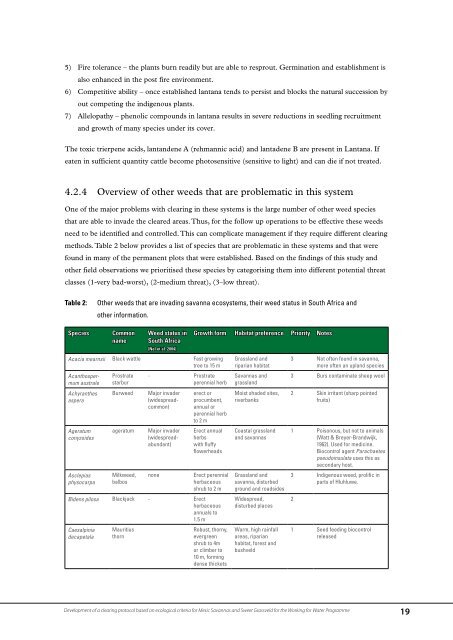Euston-Brown, D., Rathogwa, N & Richardson ... - DWA Home Page
Euston-Brown, D., Rathogwa, N & Richardson ... - DWA Home Page
Euston-Brown, D., Rathogwa, N & Richardson ... - DWA Home Page
Create successful ePaper yourself
Turn your PDF publications into a flip-book with our unique Google optimized e-Paper software.
5) Fire tolerance – the plants burn readily but are able to resprout. Germination and establishment is<br />
also enhanced in the post fire environment.<br />
6) Competitive ability – once established lantana tends to persist and blocks the natural succession by<br />
out competing the indigenous plants.<br />
7) Allelopathy – phenolic compounds in lantana results in severe reductions in seedling recruitment<br />
and growth of many species under its cover.<br />
The toxic trierpene acids, lantandene A (rehmannic acid) and lantadene B are present in Lantana. If<br />
eaten in sufficient quantity cattle become photosensitive (sensitive to light) and can die if not treated.<br />
4.2.4 Overview of other weeds that are problematic in this system<br />
One of the major problems with clearing in these systems is the large number of other weed species<br />
that are able to invade the cleared areas. Thus, for the follow up operations to be effective these weeds<br />
need to be identified and controlled. This can complicate management if they require different clearing<br />
methods. Table 2 below provides a list of species that are problematic in these systems and that were<br />
found in many of the permanent plots that were established. Based on the findings of this study and<br />
other field observations we prioritised these species by categorising them into different potential threat<br />
classes (1-very bad-worst), (2-medium threat), (3–low threat).<br />
Table 2: Other weeds that are invading savanna ecosystems, their weed status in South Africa and<br />
other information.<br />
Species Common<br />
name<br />
Weed status in<br />
South Africa<br />
(Nel et al. 2004)<br />
Acacia mearnsii Black wattle Fast growing<br />
tree to 15 m<br />
Acanthospermum<br />
australe<br />
Achyranthes<br />
aspera<br />
Ageratum<br />
conyzoides<br />
Asclepias<br />
physocarpa<br />
Prostrate<br />
starbur<br />
Burweed Major invader<br />
(widespreadcommon)<br />
ageratum Major invader<br />
(widespreadabundant)<br />
Milkweed,<br />
balbos<br />
- Prostrate<br />
perennial herb<br />
Growth form Habitat preference Priority Notes<br />
erect or<br />
procumbent,<br />
annual or<br />
perennial herb<br />
to 2 m<br />
Erect annual<br />
herbs<br />
with fluffy<br />
flowerheads<br />
none Erect perennial<br />
herbaceous<br />
shrub to 2 m<br />
Bidens pilosa Blackjack - Erect<br />
herbaceous<br />
annuals to<br />
1.5 m<br />
Caesalpinia<br />
decapetala<br />
Mauritius<br />
thorn<br />
Robust, thorny,<br />
evergreen<br />
shrub to 4m<br />
or climber to<br />
10 m, forming<br />
dense thickets<br />
Grassland and<br />
riparian habitat<br />
Savannas and<br />
grassland<br />
Moist shaded sites,<br />
riverbanks<br />
Coastal grassland<br />
and savannas<br />
Grassland and<br />
savanna, disturbed<br />
ground and roadsides<br />
Widespread,<br />
disturbed places<br />
Warm, high rainfall<br />
areas, riparian<br />
habitat, forest and<br />
bushveld<br />
3 Not often found in savanna,<br />
more often an upland species<br />
3 Burs contaminate sheep wool<br />
2 Skin irritant (sharp pointed<br />
fruits)<br />
1 Poisonous, but not to animals<br />
(Watt & Breyer-Brandwijk,<br />
1962). Used for medicine.<br />
Biocontrol agent Parachaetes<br />
pseudoinsulata uses this as<br />
secondary host.<br />
3 Indigenous weed, prolific in<br />
parts of Hluhluwe.<br />
Development of a clearing protocol based on ecological criteria for Mesic Savannas and Sweet Grassveld for the Working for Water Programme<br />
2<br />
1 Seed feeding biocontrol<br />
released<br />
1
















